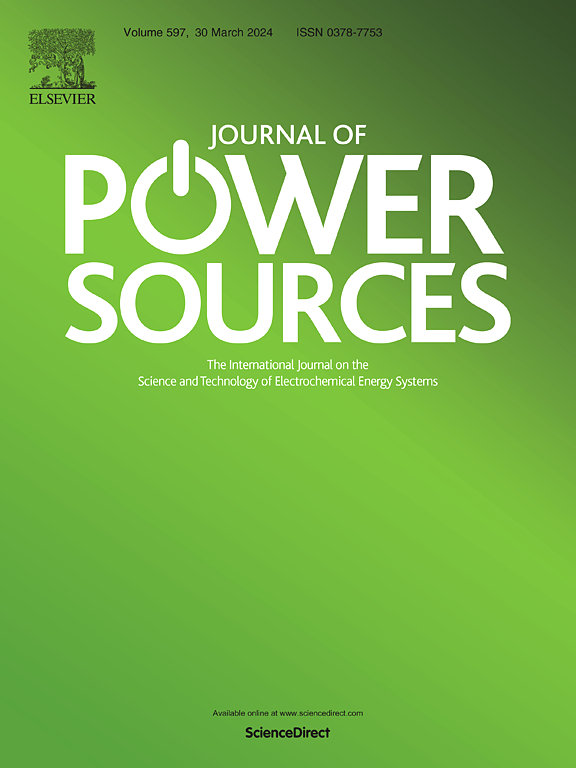基于先进光纤传感的锂离子电池长期循环内部温度演变研究
IF 8.1
2区 工程技术
Q1 CHEMISTRY, PHYSICAL
引用次数: 0
摘要
在锂离子电池的整个使用寿命期间,精确的内部温度监测对于确定锂离子电池的性能和开发管理技术至关重要。针对如何通过非破坏性技术解锁电池内部温度的难题,开发了一种包含光学传感器的商用微型测量装置,该装置采用集成功能电极设计,将光学传感器植入电池内部。对袋状电池进行的长期循环试验显示,在1C下循环1300次后容量保留率为74.94%,在2C下循环1300次后容量保留率为71.14%。传感技术对电池的电化学性能没有影响,进一步的证据得到了事后分析的支持。通过研究电池全寿命周期内的温度演变,建立了整个寿命周期放电过程中温升速率的预测公式,拟合结果误差小于5%。提出了温度平台消失作为监测电池容量衰减是否接近80%的评价指标,适宜的判据估计误差小于1%。此外,对于NCM-M-2C电池,在2C恒流放电条件下,经过1300次循环后,温升速率从0.22°C/min(寿命开始)增加到0.55°C/min(寿命结束)。这项研究为开发先进的电池管理和通过操作传感设计更安全的高能量密度电池开辟了新的途径。本文章由计算机程序翻译,如有差异,请以英文原文为准。
Internal temperature evolution of lithium-ion battery over long-term cycling via advanced fiber sensing
Accurate internal temperature monitoring for lithium-ion batteries over the whole lifespan is critical to determine their performance and develop the management techniques. Facing the challenging task of unlocking the internal temperature by a non-destructive technique, a commercial miniature measurement device involving optical sensors is developed, in which the optical sensor is implanted inside the battery with an integrated functional electrode design. Long-term cycling tests are conducted on pouch cells showing capacity retention of 74.94 % after 1300 cycles at 1C and 71.14 % after 1300 cycles at 2C. The sensing technology does not affect the electrochemical performance of the battery, and further evidence is supported by the post-mortem analysis. A prediction formulation of the temperature rise rate during the discharge process throughout the life cycle is established by investigating the temperature evolution over the whole lifespan of the cell, and the error of the fitting result is less than 5 %. Furthermore, the disappearance of the temperature plateau is developed as an evaluation indicator to monitor whether the battery capacity fade is close to 80 %, and the suitable criterion achieves an estimation error of less than 1 %. Moreover, for the cell of NCM-M-2C, after 1300 cycles, the temperature rise rate increased from 0.22 °C/min (beginning of life) to 0.55 °C/min (end of life) under 2C constant current discharging condition. This study opens new avenues to develop advanced battery management and the design of safer energy-dense batteries through operando sensing.
求助全文
通过发布文献求助,成功后即可免费获取论文全文。
去求助
来源期刊

Journal of Power Sources
工程技术-电化学
CiteScore
16.40
自引率
6.50%
发文量
1249
审稿时长
36 days
期刊介绍:
The Journal of Power Sources is a publication catering to researchers and technologists interested in various aspects of the science, technology, and applications of electrochemical power sources. It covers original research and reviews on primary and secondary batteries, fuel cells, supercapacitors, and photo-electrochemical cells.
Topics considered include the research, development and applications of nanomaterials and novel componentry for these devices. Examples of applications of these electrochemical power sources include:
• Portable electronics
• Electric and Hybrid Electric Vehicles
• Uninterruptible Power Supply (UPS) systems
• Storage of renewable energy
• Satellites and deep space probes
• Boats and ships, drones and aircrafts
• Wearable energy storage systems
 求助内容:
求助内容: 应助结果提醒方式:
应助结果提醒方式:


